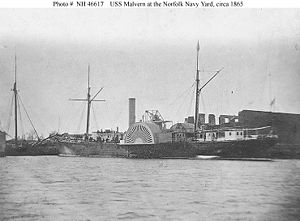USS Malvern (1860)
 | |
| Career (US) | 100x35px |
|---|---|
| Laid down: | date unknown |
| Launched: | 1860 |
| Acquired: | December 10, 1963 |
| Commissioned: | February 9, 1864 |
| Decommissioned: | October 24, 1865 |
| Struck: | (est.) 1865 |
| Captured: |
at sea by Union forces, April 1863 |
| Fate: | sold, 1866 |
| General characteristics | |
| Displacement: | 1,477 tons |
| Length: | 239 ft 4 in (72.95 m) |
| Beam: | 33 ft (10 m) |
| Draft: | 10 ft (3.0 m) |
| Propulsion: | steam engine |
USS Malvern (1860) was a large steamer captured by the Union Navy during the American Civil War. She was then used by the Union Navy to patrol navigable waterways of the Confederacy to prevent the South from trading with other countries.
Malvern was built in 1860 as William G. Hewes by Harlan and Hollingsworth Co., Wilmington, Delaware, for Charles Morgan’s Southern Steamship Co. She commenced regular service between New York City and New Orleans, Louisiana, January 11, 1861.
Contents
Seized by the Confederacy when war commenced
As William G. Hewes she was seized April 28 by the Governor of Louisiana and put into service as a Confederate blockade runner, although she was not officially registered as a Confederate steamer until April 5, 1862. Because of her speed, maneuverability, and large cargo capacity Hewes was of far greater value as a blockade running transport than as a gunboat. Few of her contemporaries were able to match the 1,440 bale payload of cotton that she carried to Havana, Cuba, in April.
When Admiral David Farragut captured New Orleans, Louisiana, in April 1862, Hewes shifted her operations from there to Charleston, South Carolina, and Wilmington, North Carolina. She was then renamed Ella and Annie. Under the Importing & Exporting Co. of South Carolina she renewed blockade running to Bermuda in April 1863.
Captured by Union forces
Damage sustained during a hurricane in September necessitated repairs in Bermuda. Ella and Annie departed there November 5 in company with steamer R. E. Lee. The two ships separated off Carolina and Ella and Annie steamed for Wilmington, North Carolina. She was delayed by a storm and intercepted the morning of November 8 by USS Niphon (1863) off New Inlet, North Carolina. Capt. Frank N. Bonneau, CSN, in command of the blockade runner, rammed the northern gunboat in a desperate attempt at evasion. A broadside from Niphon, Acting Master Joseph B. Breck, USN, in command, killed one man in Ella and Annie, riddled her hull, and brought her to.
A boarding party from Niphon captured Ella and Annie and her valuable cargo, and a prize crew took her to Boston, Massachusetts. Captain Bonneau was later convicted of piracy by a Boston court, but the presiding officer, who had been a flag officer himself, suspended the sentence on the grounds that he would have acted in a like manner had he been in similar circumstances.
Ella and Annie was condemned as a prize of war and sold to the Navy. Hastily armed, renamed Malvern and provisionally commissioned at the Boston Navy Yard December 10, she was sent to intercept Chesapeake, which had been hijacked at sea by passengers professing allegiance to the Confederacy. Chesapeake was found abandoned, taken to Halifax, Nova Scotia, and turned over to British authorities.
Malvern was formally commissioned February 9, 1864 at Boston Navy Yard. Assigned to the North Atlantic Blockading Squadron, she became Admiral David Dixon Porter’s flagship. She participated in the campaign that resulted in the capture of Fort Fisher, North Carolina, in December 1864 and January 1865. She captured blockade running steamers Stag and Charlotte January 19 off New Inlet, North Carolina, and participated in the attack February 18 on Fort Anderson, Cape Fear River.
Malvern transports President Abraham Lincoln to Richmond
She was frequently utilized for conferences between General Ulysses S. Grant, Admiral Porter, and President Abraham Lincoln. Her last notable service for the Navy was to convey the President up the James River to Richmond, Virginia, when that city was evacuated by the Confederates April 2. Malvern decommissioned October 24 at New York City.
Post-war service after decommissioning
Malvern was sold at auction at New York to S. G. Bogart, who promptly resold her to her original owner. She was again named William G. Hewes and reconditioned for passenger and freight service at Wilmington, Delaware, during January 1866. Charles Morgan then operated her from New Orleans to the Texas Gulf ports until 1878, when he turned his steamers over to the Louisiana & Texas RR., which he owned.
Hewes served in the West Indies fruit trade for many years. She was caught in a violent gulf storm in February 1895 and wrecked on Colorado Reef off the coast of Cuba.
References
- This article includes text from the public domain Dictionary of American Naval Fighting Ships. The entry can be found here.
